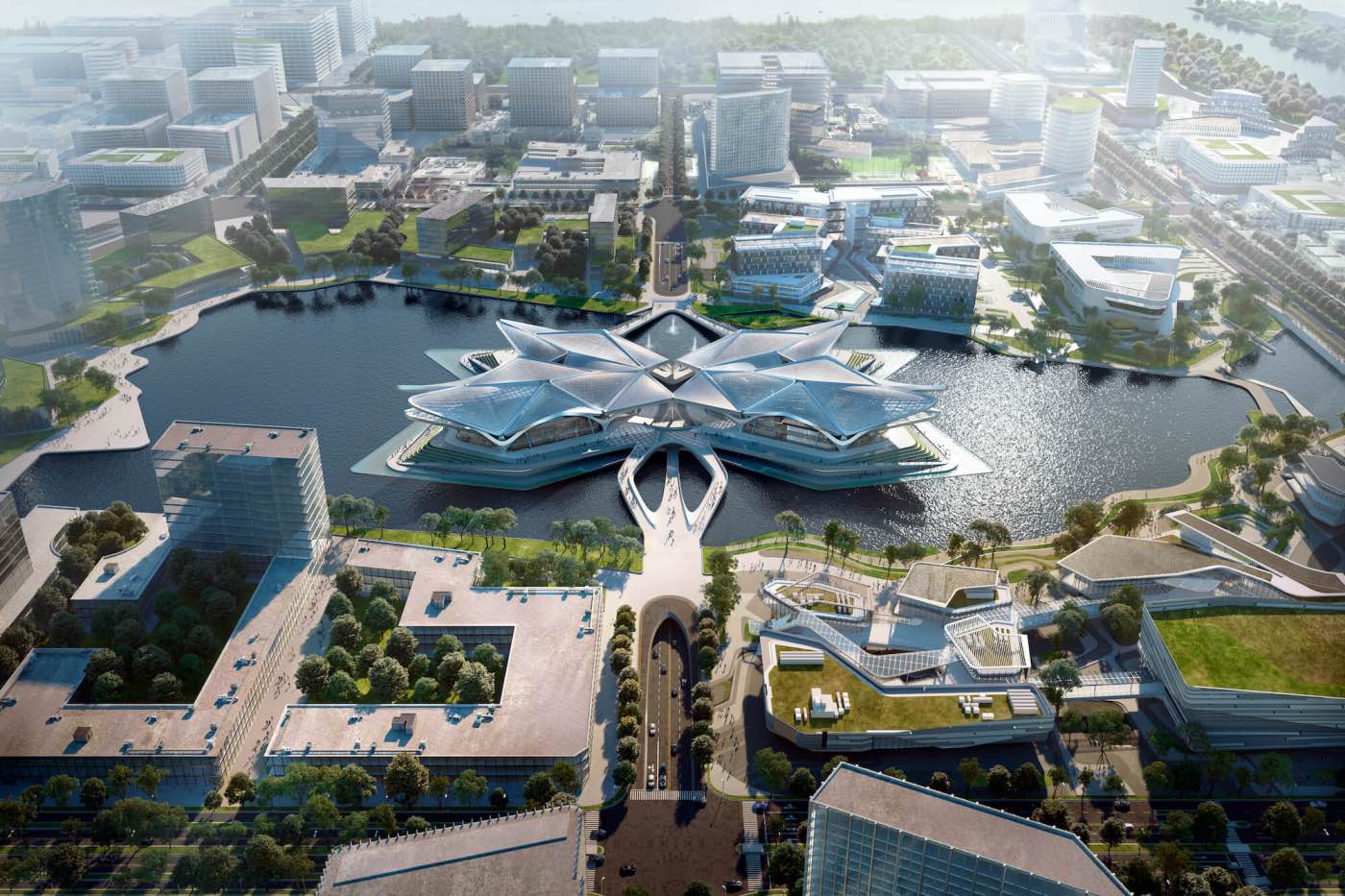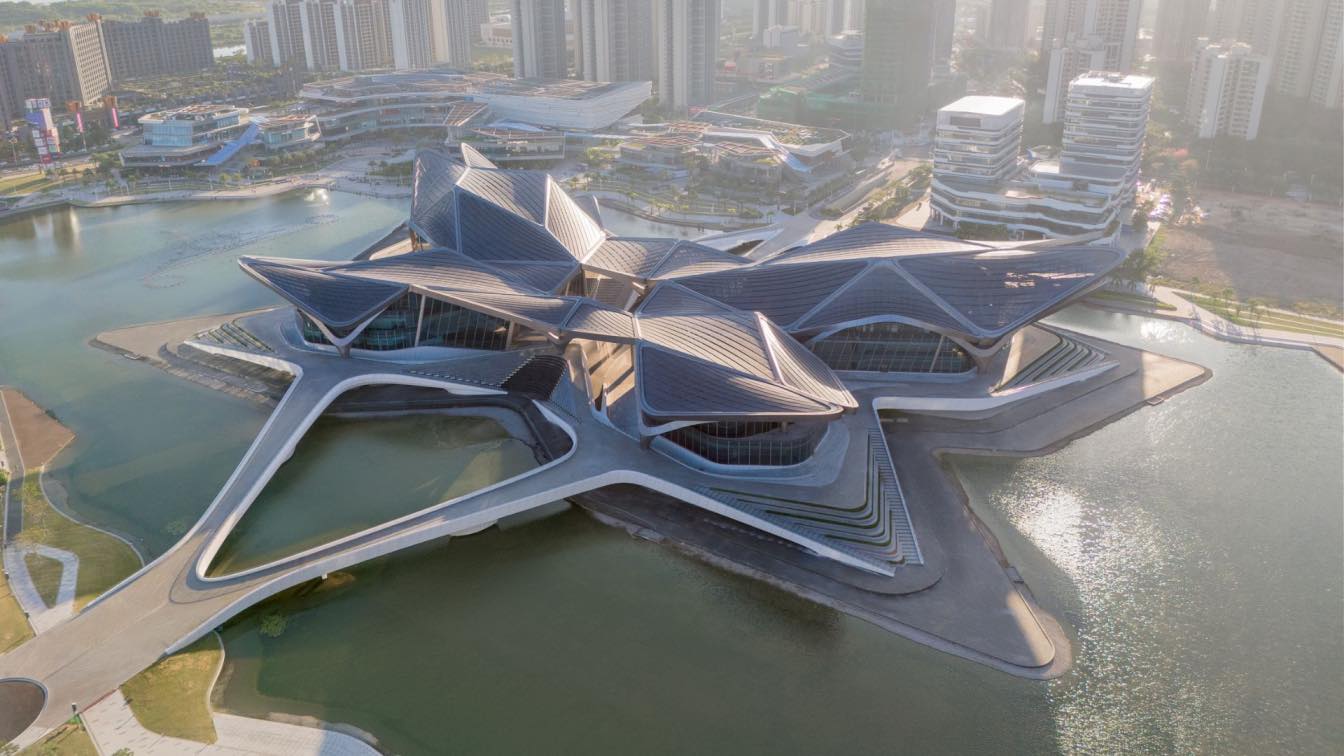Zaha Hadid Architects: Construction works are progressing on the site of the Zhuhai Jinwan Civic Art Centre. The steel structure of its lattice roof canopy has now been installed over two of the centre’s four cultural venues.
Designed as a hub of contemporary creativity within one of the world’s most dynamic regions, the Zhuhai Jinwan Civic Art Centre is located at the heart of Jinwan district’s Western Ecological New Town where the new Zhuhai Airport Intercity railway provides direct connections with Zhuhai’s city centre, its airport and Hengqin district, as well as Guangzhou, Shenzhen, Macau and Hong Kong via interchanges.
 Render by Minmud
Render by Minmud
Integrating four distinct cultural institutions for the city: a 1200-seat Grand Theatre; a 500-seat Multifunctional Hall, a Science Centre; and an Art Museum, each venue within the centre incorporates unique characteristics to create the most engaging visitor experiences, yet all are united by a coherent formal and structural logic that spans 170 meters wide from east to west and 270 meters long from north to south.
Arranged symmetrically, the two larger and two smaller venues are connected by a central plaza that serves as a shared external foyer to each of the four cultural institutions. Glazed walls facing this courtyard enable visitors to determine the individuality and character of each venue. The Grand Theatre and Art Museum are very light in their materiality, while the Multifunctional Hall and Science Center have a much darker palette of materials.
 Render by Minmud
Render by Minmud
Echoing the chevron patterns of migratory birds flying in formation over southern China, the latticed steel canopies over each venue are configured through repetition, symmetry and scale variation; resulting in a composition of related elements that respond to the different functional requirements of each building. Every building-module of the roof is self-supporting and self-stabilising. The repetition of the modules optimises pre-fabrication, pre-assembly and the use of modular construction.
 Render by Minmud
Render by Minmud
The centre’s distinctive roof structure unites the different venues under a network of reticulated shells soaring above the four buildings. Interconnecting bridges and voids define a vibrant public plaza with views to the centre’s interiors as well as to the surrounding promenades with their cafés, restaurants and educational facilities. The design optimizes natural light in all public areas and enhances connectivity; creating engaging civic spaces for Zhuhai’s residents to enjoy throughout the day and evening.
 Render by Slashcube
Render by Slashcube
Ramps invite visitors to the rooftop piazza where footbridges and stairs connect through a central void to each venue; glazed façades provide transparency and welcome the community onto its public plazas beneath the sweeping roof structure. An external amphitheatre on the west side of the centre allows for outdoor performances and activities.
The centre’s landscaping and surrounding lake are designed as integral elemets within Zhuhai’s ‘sponge city’ initiative that targets the natural permeation, storage and re-use of at least 70% of the city’s rainwater; using aquatic flora and fauna to naturally filter contaminants. Humidity and soil-moisture sensors within the landscaping’s irrigation system will control and reduce water consumption.
 Render by Methanoia
Render by Methanoia
Optimized for thermal performance, the double-insulated glazing of the building’s envelope is protected by the latticed roof canopy which incorporates perforated aluminium panels to provide external solar shading. The perforations within the panels vary in size to allow differing degrees of sunlight within the centre’s interior spaces in accordance to their programming requirements, solar gain and orientation.
 Render by Methanoia
Render by Methanoia
Energy consumption and indoor air quality monitoring systems with intelligent control will automatically adjust the centre’s interior environments for optimal comfort and energy reduction. Waste heat recovery will be used to meet the centre’s hot water demand with water-saving appliances connected to the centre’s water recycling system.
 Render by Minmud
Render by Minmud
Designed to achieve two stars within China’s Green Building Evaluation Standard, the selection and procurement of the centre’s structural components has prioritized recycled materials.
 image © Zaha Hadid Architects
image © Zaha Hadid Architects
 image © Zaha Hadid Architects
image © Zaha Hadid Architects
PROJECT TEAM
Architect: Zaha Hadid Architects
Design: Zaha Hadid and Patrik Schumacher
Project Directors: Satoshi Ohashi, Charles Walker
Project Senior Associate: Lydia Kim
Project Architects: Mei-Ling Lin, Aurora Santana (SD)
Package Leads: Mei-Ling Lin, Elena Scripelliti
Project Team: Armando Bussey, Marius Cernica, Grace Chung, Nelli Denisova, Xuexin Duan, Kaloyan Erevinov, Nassim Eshaghi, Kate Hunter, Yang Jingwen, Reza Karimi, Ben Kikkawa, Lydia Kim, Julian Lin, Mei-Ling Lin, Valeria Mazzilli, Sareh Mirseyed Nazari, Massimo Napoleoni, Yevgeniya Pozigun, Cao Qi, Qiuyu Zhao, Aurora Santana, Hannes Schafelner, Michael Sims, Patrik Schumacher, Sharan Sundar, Maria Touloupou, Chao Wei, Charles Walker
Competition Team: Armando Bussey, Clara Martins, Cristiano Ceccato, Charles Walker, Ed Gaskin, Filippo Nassetti, Jinqi Huang, Juan Liu, Lydia Kim, Julian Lin, Satoshi Ohashi, Paulo Flores, Harry Spraiter, Patrick Schumacher, Houzhe Xu, Simon Yu
LDI: Beijing Institute of Architecture & Design South China Centre
CONSULTANTS:
Landscape Consultant: Beijing Institute of Architecture & Design (South China Centre)
Acoustic Consultant: East China Architectural Design & Research Institute (Acoustic & Theatre Special Design & Research Division)
Façade Consultant: Zhuhai City Honghai Curtain Wall
Interior Consultant: Shenzhen Z&F Culture Construction
Amplify Consultant: Radio, Film & TV Design and Research Institute
Signage Consultant: W&T Design
Lighting consultant: Shenzhen Global Lighting Technology
Theater Consultant:Shanghai DeYi Engineering Technology
BIM Consultant:Beijing BIMTechnologie
Green Building Consultant:Guangdong JORJUN Green Building Technology





